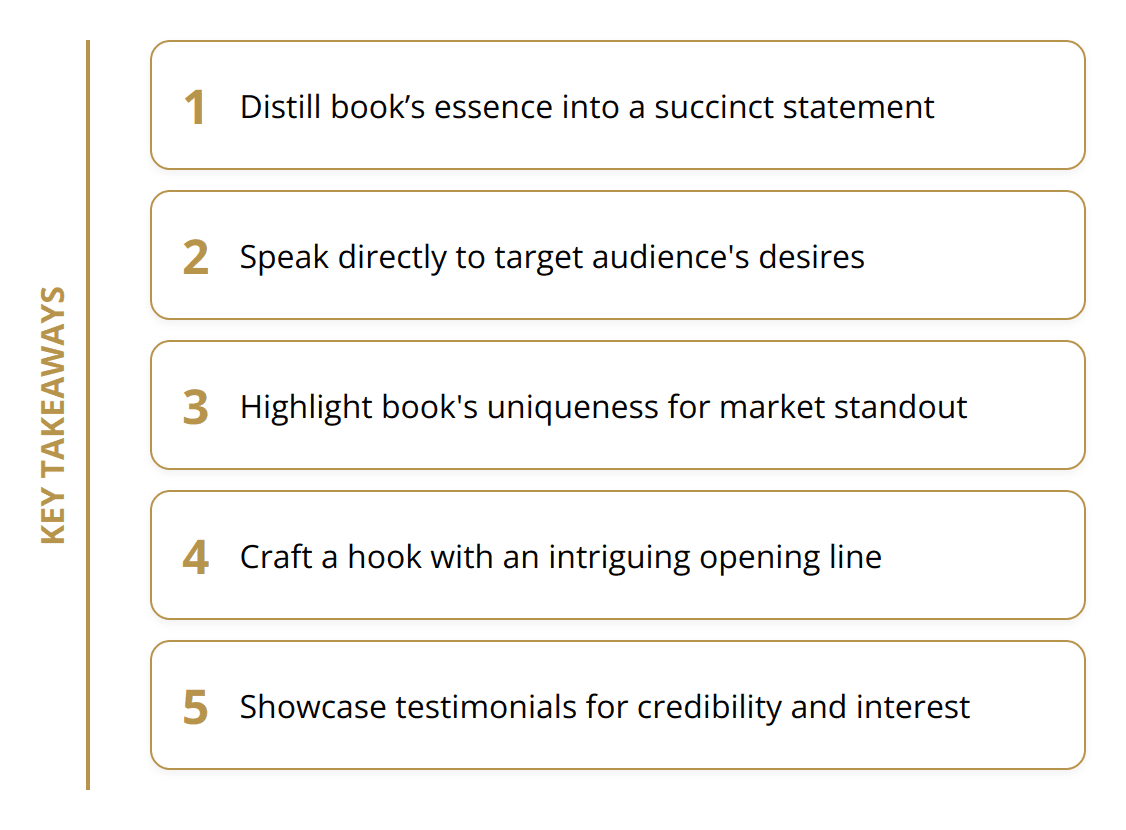At Beverly Hills Publishing, we understand the power of a well-crafted book description in capturing the interest of potential readers. A compelling description not only piques curiosity but also plays a key role in converting browsers into buyers.
In this guide, we’ll share practical advice and techniques for writing book descriptions that engage and intrigue your audience, setting your work apart in a crowded marketplace.
Crafting Engaging Descriptions
Understanding the core purpose of a book description is fundamental in writing one that effectively engages readers. It’s not just about summarizing content; it’s about hooking your target audience, showcasing your book’s uniqueness, and motivating them to read further. Here’s how you can achieve these goals with precision and creativity.
Firstly, zero in on the central theme or concept of your book. This doesn’t mean rehashing the plot or giving away spoilers. Instead, it involves distilling the essence of your story or your non-fiction’s primary argument into a succinct, compelling statement. Think of it as your book’s thesis—the one idea that everything else revolves around. This clarity not only helps target readers quickly understand what your book offers but also sets the expectation right from the start.

Understanding your target audience is as critical as knowing your book inside out. Different demographics have varying preferences, pain points, and desires. Your book description should speak directly to these, using language and emotional appeals that resonate. For a romance novel, for example, emphasizing the emotional journey of the characters could be more effective than focusing solely on the plot. For a self-help book, directly addressing the reader’s aspirations or challenges can create an immediate connection.
Finally, distinguishing your book from others in the same genre is vital in today’s saturated market. This involves framing your narrative or subject matter in a way that highlights its novelty or the fresh perspective you bring. Is your detective novel set in an era or location that’s underexplored in the genre? Does your self-improvement book introduce a groundbreaking method or philosophy? Pinpoint what makes your work a standout and ensure this is front and center in your description.

By effectively leveraging this three-pronged approach, you’ll not only grab attention but also build interest and desire within your potential readers, paving the way for better engagement and sales. Remember, a powerful book description is an invitation—a promise of sorts to your readers about the journey you’re offering them. Make it irresistible.
Writing That First Line
An unforgettable book description begins with a hook – a powerful opening line that grabs the reader’s attention and refuses to let go. This initial sentence sets the tone and anticipates the journey the reader is about to embark on. Crafting this pivotal element requires a blend of creativity, precision, and insight into the book’s essence. Here’s how to make it work.

Start with intrigue or a compelling statement that raises questions in the reader’s mind. This could be a bold claim, an intriguing fact about your story’s world, or a provocative statement from your protagonist. The goal is to make the reader think, “I need to know more.” For non-fiction, presenting a startling statistic or a controversial viewpoint right off the bat can be equally effective.
Moving beyond the opening line, a summary that captures the essence of your book without giving away key plot points or conclusions is essential. It’s like a movie trailer for your book: reveal enough to build interest, but leave enough out to drive the audience to want the full experience. An effective technique is to focus on the central conflict or challenge, which provides a snapshot of what’s at stake without spoiling the outcome.

Credibility plays a significant role in convincing potential readers of your book’s worth. If your work has received critical accolades, awards, or endorsements, mentioning these in your description can significantly bolster your book’s appeal. It’s not just about flaunting achievements; it’s about providing social proof that your book is a worthwhile investment of time and attention. However, it’s vital to integrate these elements naturally into the description, ensuring they complement rather than overwhelm the core message you’re conveying about your book’s value and appeal.
Here are some nuanced strategies to make every word count in your description:
- Use active voice: It makes your description more dynamic and engaging.
- Emphasize benefits: Especially for non-fiction, highlighting how the reader will grow or what they’ll learn can be a powerful motivator.
- Create emotional resonance: Use emotive language to connect with the reader’s feelings, aspirations, or fears.
- Be concise: Keep your description tight and impactful. Every word should earn its place.
- Focus on readability: Short paragraphs and bullet points can make the description easier to scan and understand at a glance.
By incorporating these strategies into your book description, you can create a compelling narrative that not only captures interest but also drives readership. Remember, the goal is to entice, intrigue, and assure potential readers that your book is exactly what they’re looking for – or didn’t know they needed.
Crafting Compelling Descriptions
Mastering the art of writing effective book descriptions is akin to weaving a tapestry that captures the essence of your narrative or subject matter while enticing readers to delve deeper. Let’s explore the methodologies that elevate your book description from ordinary to extraordinary, ensuring it speaks directly to the heart and mind of your potential readers.
A persuasive tone intertwined with an active voice is the cornerstone of a compelling book description. Active voice breathes life into your words, making the narrative vibrant and engaging. Readers are drawn to descriptions that feel dynamic and energetic, as it mirrors the excitement you wish to convey about your book.
Focusing on the emotional journey or the value your book provides is paramount. For fiction, weaving the emotional trajectory of your characters into the description allows readers to form a connection even before they turn the first page. In non-fiction, the value proposition—what readers will take away or how it will transform their understanding of a topic—should be crystal clear. This connection promises readers an experience, not just a read.
Creating intrigue without revealing the plot requires a delicate balance. Your description should be like a magician’s trick—show enough to fascinate but keep the mystery intact. Highlight the stakes or the central conflict to give readers a taste of the thrill, challenge, or enlightenment they will find within your pages. Tease the readers’ curiosity by presenting questions that your book promises to answer, thus making the act of reading your book the key to unveiling secrets or gaining knowledge.
Here are practical tips to weave these elements seamlessly into your book description:
- Highlight the stakes: Make it clear what is at risk or what can be gained by embarking on this journey with you.
- Showcase testimonials: If available, brief, powerful endorsements from credible sources can significantly amplify interest.
- Use vivid language: Choose words that evoke imagery, emotion, and curiosity.
- Keep it succinct: Trim fluff to ensure every word adds value and invites interest.
By treating your book description as an integral part of your book’s journey rather than an afterthought, you craft an invitation that is hard to resist. This is not just about selling a book; it’s about promising an experience that is too compelling to pass up.
Remember, the goal is always to stir the imagination, touch the emotions, and spark the curiosity of your readers, leading them to one conclusion: they must read your book.
Final Thoughts
A well-constructed book description has the remarkable power to transform casual browsers into dedicated readers and boost sales. It acts as the bridge between an author’s vision and the reader’s expectation, laying the groundwork for an engaging and fulfilling reading experience. Engaging readers from the get-go and maintaining their interest is the hallmark of an effective book description.

We encourage authors to experiment with different writing techniques and tones to discover what resonates most with their target audience. The art of crafting a compelling book description is not one-size-fits-all; it demands creativity, precision, and a willingness to revise. Experimentation allows authors to refine their approach, ensuring the description aligns perfectly with the book’s essence and appeal.
Continuously refining a book description is a testament to an author’s dedication to their craft and their readers. With each revision, the description becomes more polished and potent, maximizing reader engagement and driving interest. This iterative process is crucial in today’s competitive landscape, where capturing and maintaining reader attention is paramount.
At Beverly Hills Publishing, we understand the impact of a book description on an author’s success. Our holistic approach to publishing and marketing is designed to position authors as industry leaders, enhancing their visibility and influence. We believe in the power of collaboration to elevate an author’s message, ensuring their book reaches the widest possible audience and achieves the success it deserves.
By prioritizing a compelling book description, authors set the stage for a rewarding connection with their readers, establishing a foundation for lasting impact and success. The journey from a first draft to a polished book description is a critical part of the publishing process, underscoring the author’s vision and commitment to their audience. Embrace the challenge, and let every word of your book description invite readers into the incredible world you’ve created.















































































































































































































































